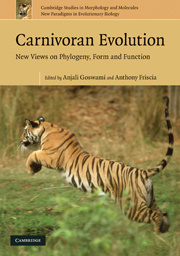Carnivoran Evolution New Views on Phylogeny, Form and Function Cambridge Studies in Morphology and Molecules: New Paradigms in Evolutionary Bio Series
Langue : Anglais
Coordonnateurs : Goswami Anjali, Friscia Anthony

Showcases current advances in our understanding of the evolution of the mammalian order Carnivora.
Members of the mammalian clade Carnivora have invaded nearly every continent and ocean, evolving into bamboo-eating pandas, clam-eating walruses and of course, flesh-eating sabre-toothed cats. With this ecological, morphological and taxonomic diversity and a fossil record spanning over sixty million years, Carnivora has proven to be a model clade for addressing questions of broad evolutionary significance. This volume brings together top international scientists with contributions that focus on current advances in our understanding of carnivoran relationships, ecomorphology and macroevolutionary patterns. Topics range from the palaeoecology of the earliest fossil carnivorans to the influences of competition and constraint on diversity and biogeographic distributions. Several studies address ecomorphological convergences among carnivorans and other mammals with morphometric and Finite Element analyses, while others consider how new molecular and palaeontological data have changed our understanding of carnivoran phylogeny. Combined, these studies also illustrate the diverse suite of approaches and questions in evolutionary biology and palaeontology.
1. Introduction to carnivora Anjali Goswami; 2. Phylogeny of the carnivora and carnivoramorpha, and the use of the fossil record to enhance understanding of evolutionary transformations John J. Flynn, John A. Finarelli and Michelle Spaulding; 3. Phylogeny of the viverridae and 'viverrid-like' feliforms Geraldine Veron; 4. Molecular and morphological evidence for ailuridae and a review of its genera Michael Morlo and Stéphane Peigné; 5. The influence of character correlations on phylogenetic analyses: a case study of the carnivoran cranium Anjali Goswami and P. David Polly; 6. What's the difference?: a multiphasic allometric analysis of fossil and living lions Matthew H. Benoit; 7. Evolution in carnivora: identifying a morphological bias Jill A. Holliday; 8. The biogeography of carnivore ecomorphology Lars Werdelin and Gina D. Wesley-Hunt; 9. Comparative ecomorphology and biogeography of herpestidae and viverridae (carnivora) in Africa and Asia Gina D. Wesley-Hunt, Reihaneh Dehghani and Lars Werdelin; 10. Ecomorphological analysis of carnivore guilds in the Eocene through Miocene of Laurasia Michael Morlo, Gregg F. Gunnell and Doris Nagel; 11. Ecomorphology of North American Eocene carnivores: evidence for competition between carnivorans and creodonts Anthony R. Friscia and Blaire Van Valkenburgh; 12. Morphometric analysis of cranial morphology in pinnipeds (mammalia, carnivora): convergence, ecology, ontogeny, and dimorphism Katrina E. Jones and Anjali Goswami; 13. Tiptoeing through the trophics: geographic variation in carnivoran locomotor ecomorphology in relation to environment P. David Polly; 14. Interpreting sabretooth cat (carnivora; felidae; machairodontinae) postcranial morphology in light of scaling patterns in felids Margaret E. Lewis and Michael R. Lague; 15. Cranial mechanics of mammalian carnivores: recent advances using a finite element approach Stephen Wroe.
Anjali Goswami is a lecturer in palaeobiology in the Department of Genetics, Evolution and Environment and the Department of Earth Sciences at University College London. Her research focuses on large-scale patterns of evolution and development, integrating data from embryos to fossils to understand influences on morphological evolution in mammals. Her interest in carnivoran evolution was first established in the years prior to graduate school when she worked as an intern and then researcher in tiger conservation at Bandhavgarh National Park, India. In between countless hours measuring skulls in dark museum basements, Anjali has conducted palaeontological fieldwork in the Western U.S., India, Svalbard, Chile, Peru, and Madagascar, collecting everything from Triassic dinosaurs to Palaeocene plants. She currently serves as the co-chair of the scientific program committee and a member of the media response team for the Society of Vertebrate Paleontology and has appeared as a scientific expert on BBC News and National Geographic.
Anthony Friscia's research covers small carnivores, both extant and extinct. He is particularly interested in questions about ecomorphology and community structure. He has done field work in Utah, Pakistan, Egypt, and Kenya. He is a member of the Society of Vertebrate Paleontology, the American Society of Mammalogists, the Paleontological Society, Society for Integrative and Comparative Biology, and the National Science Teachers Association. He is currently faculty at the University of California - Los Angeles, where he has won a number of teaching awards for his work teaching evolution to non-science majors and human anatomy, and where he also works to shape their science general education curriculum. He has been an invited speaker and researcher at recent Darwin Anniversary celebrations and workshops on the La Brea tar seeps.
Anthony Friscia's research covers small carnivores, both extant and extinct. He is particularly interested in questions about ecomorphology and community structure. He has done field work in Utah, Pakistan, Egypt, and Kenya. He is a member of the Society of Vertebrate Paleontology, the American Society of Mammalogists, the Paleontological Society, Society for Integrative and Comparative Biology, and the National Science Teachers Association. He is currently faculty at the University of California - Los Angeles, where he has won a number of teaching awards for his work teaching evolution to non-science majors and human anatomy, and where he also works to shape their science general education curriculum. He has been an invited speaker and researcher at recent Darwin Anniversary celebrations and workshops on the La Brea tar seeps.
Date de parution : 07-2010
Ouvrage de 506 p.
17.5x24.8 cm
Date de parution : 07-2010
Ouvrage de 506 p.
18.2x25.4 cm
Disponible chez l'éditeur (délai d'approvisionnement : 14 jours).
Prix indicatif 156,60 €
Ajouter au panierThème de Carnivoran Evolution :
© 2024 LAVOISIER S.A.S.



